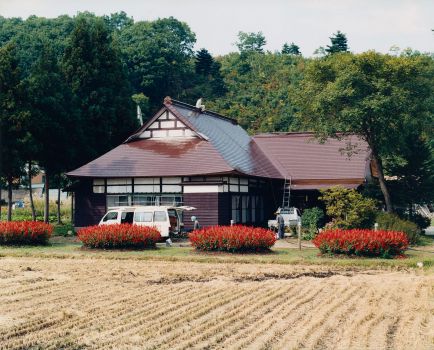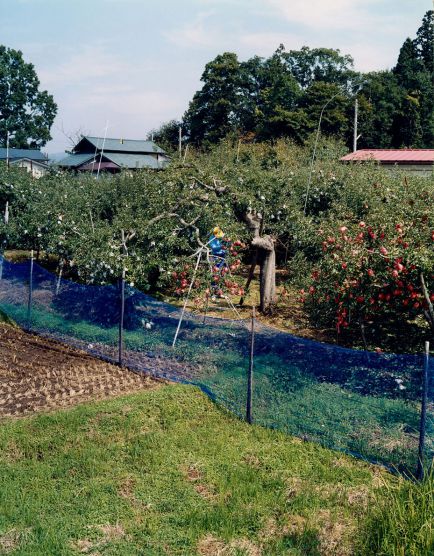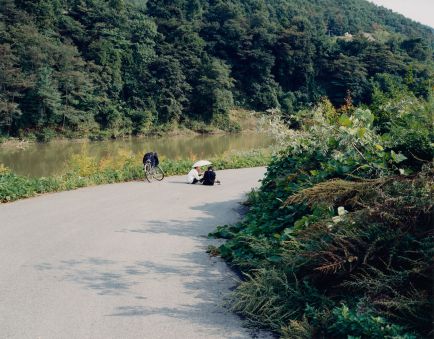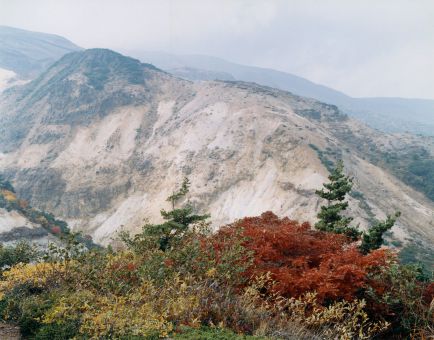Yamagata
Photographs and video 2002
Catalogue & exhibition
This work is the result of a commission from the European City of Culture Graz 2003 and EU-Japan Fest Japan Committee, Tokyo. Curator Christine Frisinghelli had selected Margherita Spiluttini (AT), Agnieszka Wołodźko and myself to work on different prefectures in Japan. My work investigates the rural landscape of Yamagata located in the Tohoku region on Honshu island.
EN
A cable-car carries me from the sunlit glow of the Shonai plain, past radiant autumn woods, up into the Zao Mountains. For the last few hundred yards to the Katta top, I stumble along on foot over bleak black rocks, through mists and bitterly cold winds that penetrate my very bones. My hands are red with the cold.
From this lofty height, Yamagata prefecture, the subject of my work, lies before me in all its dazzling splendour. Over the past few weeks, I have explored and befriended this place, teasing out images, discovering the familiar in the unfamiliar. The tension between strangeness and familiarity itself has become part of my work and has shaped my responses to the element of exotic mysti- que that so often clouds Western views of the Far East.
My images seek to describe Yamagata as a specific locality. I sought out codes and structures in the prefecture's geography that, to me, stood for the specifics of this place. Certain events have become embedded within my images or are obliquely present in them from a distance. The context in which these pictures were taken is of secondary importance. The image as object forms the centre of attention and invites the viewer to enter into a dialogue. My work not least also retraces a journey to my own self and leaves room for questions that the individual viewer can formulate out of the context of his or her own life experience.
DE
Eine Gondel trägt mich, aus der in warmes Sonnenlicht getauchten Shonai Ebene an leuchtenden Herbstwäldern vorbei, hinauf in die Zao Berge. Das letzte Stück stolpere ich zu Fuß über ödes schwarzes Gestein auf die Katta Bergspitze. Nebelschwaden und ein eißiger Wind durchdringen meine Jacke und meine Hände sind rot vor Kälte.
Mir zu Füßen liegt die Präfektur Yamagata, das Objekt meiner Arbeit der letzten Wochen. Vertraut ist sie mir geworden, habe sie mir bildlich angeeignet die Fremde bei meinen Streifzügen durch die Landschaft. Vertrautheit und Fremde sind als Spannungsfeld zu einem Teil meiner Arbeit geworden und meine Reaktion auf Mystifizierung und Exotik, die mit Betrachtungen fern- östlicher Lebensräume häufig einhergehen.
Mit meinen Bildern versuche ich Yamagata als einen spezifischen Ort zu beschreiben. Ich habe Codes und Strukturen in der Geografie gesucht, die für mich repräsentativ für die Präfektur sind. Ereignisse habe ich in die Bilder eingebettet und oder sie auf Distanz gerückt. Der Kontext aus dem meine Aufnahmen stammen verliert dadurch an Bedeutung. Das Bild als Objekt rückt in den Vordergrund und läd den Betrachter zu einem Dialog ein. Meine Arbeit beschreibt eine Reise zu mir selbst und gibt dem Betrachter Raum für Fragen, die an dessen eigenen Erfahrungskontext anknüpfen.
close
The “European Eyes on Japan” project is based on a seemingly simple concept: photo artists from various European countries are invited to focus their photographic work on one of the Japanese prefectures; the result, over the years, would be a description of the Japanese territory created by European artists of different national origin. As the title says, the aim is to discuss the view of Japan through “European Eyes”.
However, the simplicity of this concept collides directly with a vast complexity of questions: in the political debate and in artistic practice there are few fields that have been discussed in such depth in recent years as the possibilities and conditions of describing economic, social, geographical conditions and particularly the question of representing the foreign.
In this context, we should also note that projects of this nature have featured in the medium of photography since its invention. Photography seems to be the medium par excellence for recording outer conditions, its indexical properties are logically manifested in the idea of combining all the views of this world in a total archive. A photographic image satisfies our wish for a valid and veracious recording of place, however alien, as yet unseen and distant it may be. In a photograph, the world seems to speak to the viewer from within itself: this a priori credibility of the photographic image, its back-link to the factual, the “reality effect” the medium produces, constitute a seemingly unshakeable basis – at least on the part of the viewer who makes the link of what exists in the picture to what “actually once existed” the point of departure for his interpretation. These factors, however, are also the ideological pitfalls that the artists must take into consideration if they want to counter the complexity of social reality with the subjectivity of their individual standpoints, to observe and describe them, and to portray them in the context of a project such as this.
Many factors may be of interest in connection with a project such as “European Eyes on Japan”, for example the fact that the project involves the creation of commissioned artistic works that, in this sense, play a special role in the overall work of the artists: projects are created in a defined period of time, the conditions are specified by a commissioning institution, and the publication (the book, the exhibition) of the results may also be different to the photographer?s intention for his/her work. Also of interest, however, are the ideas of the commissioning institution that admits that “European Eyes” may perceive the conditions of “Japan Today” differently to “Japanese Eyes”, for example, and who uses considerable economic means and bears the organisational responsibility for publishing the results. Another interesting factor would be the question of the self-image of Japan today that is perhaps difficult to reconcile with image constructions such as the present artistic projects.
Of course, this “problematic” constellation makes such project works an exciting challenge for artists and curators; therefore, I was pleased to suggest three artists for “European Eyes on Japan 5” who were to elaborate their works in the two prefectures of Yamagata, in the north-west of Honshu, and Oita, on the southern island of Kyushu. Michael Danner was to focus on Yamagata, Margherita Spiluttini was to work exclusively in Oita, while Agnieszka Wolodzko was to visit both locations and “link up” the other two, geographically defined works.
It was very important for me to invite artists whose mode of work, methods and strategies may be harmonised with such a project: their interest in geographical and social spaces, their intelligence in using photographic means, and their very different modes of formulation and aesthetic decisions should open up a panoramic view that involves the viewer into coming to terms with the actual challenge of such projects – to find a standpoint from which to describe the (foreign) reality and to find a form that visualises as experience the construction of what is described.
close
European Eyes on Japan
EU-Japan Fest, Tokyo 2003

close
2003
Bunsho-kan Gallery, Yamagata-shi
Gallery Oasis, Oita
Studio Martinelli, Palais Thienfeld, Graz

Bunsho-kan Gallery, Yamagata-shi

Bunsho-kan Gallery, Yamagata-shi


Mikiko Kikuta, Saori Hakoda, Agnieszka Wołodźko, Nobuyuki Okabe

Gallery Oasis, Oita
Margeritha Spiluttini, Agnieszka Wołodźko

Studio Martinelli, Palais Thienfeld, Graz
Seiichi Furuya, Manfred Willmann, curator Christine Frisinghelli

Studio Martinelli, Palais Thienfeld, Graz


close

YAMAGATA SECONDARY SCHOOL





TOHOKU UNIVERSITY OF ART AND DESIGN, Yamagata

TOHOKU UNIVERSITY OF ART AND DESIGN, Yamagata
Curator CHRISTINE FRISINGHELLI AND MANFRED WILLMANN
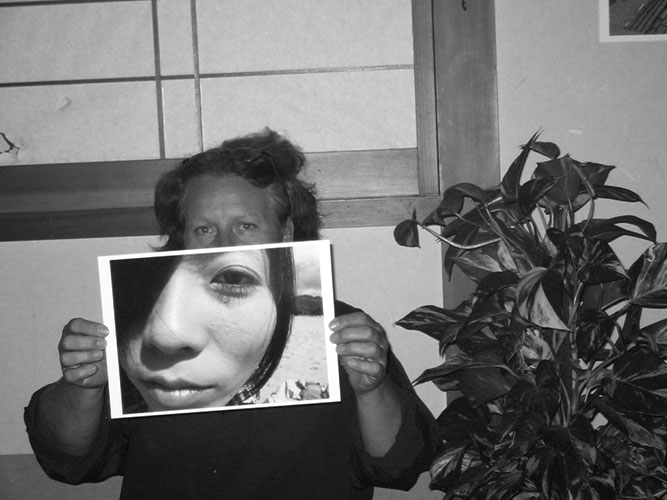
Curator CHRISTINE FRISINGHELLI
close
















